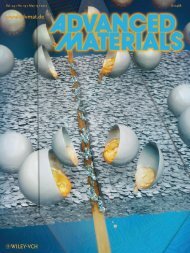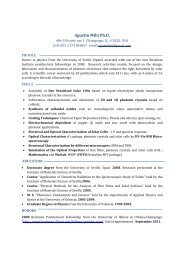Polymer Brushes for Molecular Transport - Paul Braun Research ...
Polymer Brushes for Molecular Transport - Paul Braun Research ...
Polymer Brushes for Molecular Transport - Paul Braun Research ...
Create successful ePaper yourself
Turn your PDF publications into a flip-book with our unique Google optimized e-Paper software.
3.2.2 Instrumentation<br />
A Gaertner Ellipsometer Model L116C (Gaertner Scientific Corp.) with a HeNe laser<br />
(λ=632.8 nm) was used to measure the thickness of the SAMs and the polymer brushes. Contact<br />
angle data was collected under ambient conditions using a Ramé-Hart Goniometer (Model 100-<br />
00). XPS was collected using a Kratos Axis ULTRA Imaging X-ray Photoelectron Spectrometer<br />
(Kratos Analytical Ltd.). FTIR spectra, 512 scans at 4 cm -1 resolution, were obtained using a<br />
Nexus 670 FT-IR E.S.P. (Thermo Nicolet). AFM was done using a tapping mode etched silicon<br />
probe (Digital Instruments) on a Dimension 3100 AFM (Digital Instruments). X-ray<br />
reflectometry (XRR) data was collected using an X’pert 2 (Philips) and data analysis was<br />
per<strong>for</strong>med using the WinGixa Reflectivity software package (Philips). The fluorescence<br />
emission spectra of Prodan were collected using a Jobin-Yuvon Spectrometer (Model<br />
FluoroMax-3). A Zeiss Axiovert 100 inverted light microscope (Carl Zeiss Inc.) equipped with a<br />
mercury excitation lamp, a CoolSnap fx CCD camera and a triple band filter (Chroma) was used<br />
to acquire the fluorescent microscopy data of Prodan in the patterned PNIPAAm brush. A Leica<br />
confocal laser scanning microscope (Model TS SP2) equipped with Ti:Sapphire tunable<br />
wavelength laser (Tsunami, Spectra-Physics) was used to collect fluorescence recovery after<br />
photobleaching (FRAP) images, and samples were tested under continuous flow of nitrogen or<br />
nitrogen with controlled relative humidity using a custom-made sample holder.<br />
A custom-built environmental cell was used <strong>for</strong> the variable temperature ellipsometry<br />
experiments under water. The sample was heated and cooled at less than 0.5 °C/min.<br />
3.2.3 PNIPAAm brush <strong>for</strong>mation and patterning<br />
Silicon (111) wafers were used as substrates after cleaning in boiling H2SO4:H2O2 (v/v:<br />
3/1) (CAUTION: piranha solutions are strongly oxidizing and should not be allowed to contact<br />
32




